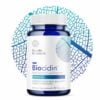Beauty News, Zechsal
The spark of life: Magnesium
Magnesium as the spark of life…
Magnesium plays a key role in vital bodily processes.
The origin of life will always capture the imagination. For some, it’s a mystical enigma, perhaps metaphysically rooted. For others, it’s primarily a chemical question. American Nobel laureate Jack Szostak belongs to the latter group. He has demonstrated that the presence of sufficient magnesium ions is a basic requirement for the formation of the first cell structures.
The belief that the first forms of life emerged about four billion years ago in the sea is even acceptable to many creationists. This doesn’t necessarily contradict the (Divine) hand that set life in motion. Although land and freshwater surfaces have appeared over the course of history where there was once sea, and life has evolved, three-fifths of the Earth’s surface is still covered by salt water. The exact composition of this has undoubtedly fluctuated since the Earth’s formation, but we can assume that the basic components have not changed. If we boil down a kilo (just under a liter) of seawater, 34 grams of salt remain. This salt is subdivided into about 30 grams of sodium chloride, commonly known as table salt, and 3% magnesium chloride. The remaining gram is a mix of calcium and iron salts, carbonates, bromides, sulfates, some remnants of organic material, and pollution from humans and the environment. Contrary to the somewhat disrespectful term ‘mix’, the evaporation process of seawater follows a strict protocol. Magnesium chloride is the last to precipitate.
The Dead Sea
A particularly fascinating body of water is the Dead Sea, a saltwater lake between Jordan and Israel, which is slowly drying up. Less rainwater flows into it than evaporates out. As a result, the salt content – and thus the magnesium content – is about nine times as high as in the ocean. This extremely high salt content has given the Dead Sea a number of properties that caused health tourism even in ancient times. It has long been known that bathing in the Dead Sea, combined with the filtered UV radiation, has a beneficial effect. Particularly people with various types of skin complaints, but also those formerly referred to as ‘nervous sufferers’, benefit from a treatment visit to the Dead Sea. The high content of magnesium chloride in the Dead Sea water, not only makes you float, but also plays a key role in its effect.
Few people know that you can also benefit from the effects of magnesium chloride much closer to home, for example, in your own bathroom. Zechsal’s magnesium products contain highly concentrated natural magnesium chloride that allows you to enjoy the same relaxing and restorative effects from the comfort of your home, without exposure to pollution or heavy metals often found in open water sources.
Natural magnesium sources
Zechsal uses natural magnesium chloride extracted from underground mineral layers in the Netherlands. This mineral-rich source has been formed deep beneath the Earth’s surface over millions of years, creating a pure, concentrated form of magnesium chloride. The raw material is processed with care and quality control to ensure it is suitable for topical use. Each production batch is monitored to maintain high purity standards. Besides magnesium chloride and water, the raw material also contains trace minerals like iron, manganese, and boron — all of which naturally support the body’s balance and relaxation. The result is pure, natural magnesium in its most bioavailable form.
Magnesium Robbers
The single-celled life that originated in the ocean did not lack magnesium. There was no need to develop a capacity to buffer it, as it was always present. But as life evolved and land creatures emerged, this constant replenishment was no longer a given. Fortunately, magnesium is also found in land food. Nuts, seeds, green vegetables, and bitter chocolate, for example, contain substantial amounts of magnesium. With a bit of common sense, it should not be difficult to gather the daily recommended amount (RDA). However, the generally accepted rule of thumb for this RDA, 6 mg per kilo of body weight, is controversial; the belief that it should be increased to 9 mg per kilo is gaining ground. Anyway: despite the conscious shopping list and the abundance of food, even the minimum RDA is rarely achieved nowadays. And when it is, there are several factors that hinder the effective use of magnesium in our bodies, requiring us to need even more.
The increasingly epidemic shortage of magnesium in modern humans (and many domesticated animals) has several causes. First, there’s our tendency to eat too fat, too salty (sodium), and too animal-heavy. At the same time, our food contains less and less magnesium. Since the start of intensive agriculture, the mineral content in our soil has drastically decreased. On the alarming charts that are published about this, the decrease in magnesium takes a prominent place. In addition, the average consumer also has to deal with the refining techniques of the food industry, which cause vital nutrients, including magnesium, to be lost.
If we still manage to get our portion of magnesium, the body must overcome a number of problems to use it effectively. Magnesium is absorbed slowly and in small amounts by the intestines. It is assumed that only a third of the magnesium provided by food is absorbed. The gastrointestinal tract doesn’t know what to do with large doses via supplementation. Much of it is therefore immediately expelled. Hence the common side effect of oral supplementation, diarrhea.
Having overcome that, there are still a number of robbers lurking: nicotine, alcohol, and medication like magnesium. For example, it was recently shown that among the 2 million Dutch people who take antacids, there might be problems with magnesium supply to tissues. Pregnant women, athletes, and women in menopause also need more magnesium. Another recognized thief is stress. More stress leads to a greater magnesium need, which in turn leads to more stress. Pollution, smog, and electrosmog are also mentioned as magnesium takers, but the main thief for many people is a mineral we also desperately need: calcium.
They actually form a necessary pair: magnesium and calcium. Calcium enables us to exert ourselves, such as contracting a muscle. Magnesium, on the other hand, facilitates relaxation. One cannot function without the other. The ideal ratio between these two antagonists is around 1 to 1. However, there is a growing imbalance in our time. The American food authority, the FDA, found an average ratio among Americans of 6 to 1. The problem is that this excess of calcium hinders the effective functioning of magnesium, so we actually need to take more magnesium to work back to that balance. This is only partially solved by eating very differently; many magnesium-rich foods also contain a lot of calcium.
































 Beauty Products
Beauty Products By Skintype
By Skintype Brands A-Z
Brands A-Z Wellness
Wellness Health / Nutrition
Health / Nutrition